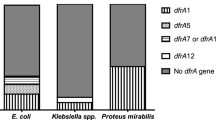Abstract
The results of a three year evaluation of the incidence and type of trimethoprim resistance in pathogens responsible for significant bacteriuria in a general hospital in Edinburgh UK, are presented and compared to results of a previous study. In the present study, trimethoprim resistance was 50% more frequent in bacteria isolated from men and nearly twice as frequent in bacteria from elderly patients. However, the proportion of trimethoprim resistant strains fell annually when resistance was measured at trimethoprim concentrations of both 10 mg/l and 1000 mg/l. The proportion of strains able to transfer trimethoprim resistance also fell by half, and there was some movement of trimethoprim resistance transposons into the bacterial chromosome. These results suggest that migration of high-level trimethoprim resistance genes into the permanent location of the bacterial chromosome is occurring.
Similar content being viewed by others
References
Fleming, M. P., Datta, N., Grüneberg, R.: Trimethoprim resistance determined by R-factors. British Medical Journal 1972, i: 726–728.
dAmyes, S. G. B., Emmerson, A. M., Smith, J. T.: Rfactor mediated trimethoprim resistance: result of two three-month clinical surveys. Journal of Clinical Pathology 1978, 31: 850–854.
Romero, E., Perducca, M.: Compatibility groups of Rfactors for trimethoprim resistance isolated in Italy. Journal of Antimicrobial Chemotherapy 1977, 3 Supplement C: 35–38.
Acar, J. F., Goldstein, F. W., Gerbaud, G. R., Chabbert, Y. A.: Plasmides de résistance au triméthoprime: transférabilité et groupe incompatibilité. Annales des Microbiologie de l'Institut Pasteur 1977, 128A: 41–47.
Towner, K. J., Pearson, N. J., Pinn, P. A., O'Grady, F.: Increasing importance of plasmid-mediated trimethoprim resistance in enterobacteria: two six-month surveys. British Medical Journal 1980, 280: 517–519.
Huovinen, P., Mantyjarvi, R., Toivanen, P.: Trimethoprim resistance in hospitals. British Medical Journal 1982, 284: 782–784.
Amyes, S. G. B., McMillan, C. J., Drysdale, J. L.: Transferable trimethoprim resistance amongst hospital isolates. In: Grassi, G. G., Sabath, L. D. (ed.): New trends in antibiotics: research and therapy, Elsevier/ North-Holland Biomedical Press, New York, 1981, p. 325–327.
Amyes, S. G. B., Drysdale, J. L., McMillan, C. J., Young, H.-K.: The diversity of trimethoprim resistance within hospital isolates. Journal of Pharmacy and Pharmacology 1982, 34: 60P.
Bachmann, B. J.: Pedigrees of some mutant strains ofEscherichia coli K-12. Bacteriological Reviews 1972, 36: 525–555.
Sharma, P. L., Sharma, K. B., Prakash, K.: Incidence of conjugative plasmids amongst multidrug resistantSalmonella typhimurium strains isolated from different parts of India (1979–1982). Indian Journal of Medical Research 1984, 79: 473–478.
Datta, N., Hedges, R. W., Shaw, E. J., Sykes, R. B., Richmond, M. H.: Properties of an R-factor fromPseudomonas aeruginosa. Journal of Bacteriology 1971, 108: 1244–1249.
Hedges, R. W., Datta, N.:fi − R factors giving chloramphenicol resistance. Nature 1971, 234: 220–221.
Smith, J. T.: R-factor gene expression in gram-negative bacteria. Journal of General Microbiology 1969, 55: 109–120.
Amyes, S. G. B., Gould, I. M.: Trimethoprim resistance plasmids in faecal bacteria. Annales de Microbiologie de l'Institut Pasteur 1984, 135B: 177–186.
Birnboim, H. C., Doly, J.: A rapid alkaline extraction procedure for screening recombinant plasmid DNA. Nucleic Acids Research 1979, 7: 1513–1523.
Young, H.-K., Amyes, S. G. B.: Trimethoprim resistance: An epidemic caused by two related transposons. In: Spitzy, K. H., Karrer, K. (ed.): Proceedings of the 13th International Congress of Chemotherapy. Verlag Egermann, Vienna, 1983, Part 87, p. 93–96.
Kraft, C. A., Platt, D. J., Timbury, M. C.: Distribution and transferability of plasmids in trimethoprim resistant urinaryEscherichia coli: a comparative study of hospital isolates. Journal of Medical Microbiology 1984, 18: 95–105.
Chirnside, E. D., Emmerson, A. M., Smith, J. T.: A follow-up survey of transferable, plasmid encoded trimethoprim resistance in a general hospital (1975–1983). Journal of Antimicrobial Chemotherapy 1985, 16: 419–434.
Towner, K. J., Wise, P. J.: Transferable resistance plasmids as a contributory cause of increasing trimethoprim resistance in general practice. Journal of Antimicrobial Chemotherapy 1983, 11: 33–39.
Towner, K. J.: A clinical isolate ofEscherichia coli owing its trimethoprim resistance to a chromosomallylocated trimethoprim transposon. Journal of Antimicrobial Chemotherapy 1981, 11: 33–39.
Author information
Authors and Affiliations
Rights and permissions
About this article
Cite this article
Amyes, S.G.B., Doherty, C.J. & Young, H.K. High-level trimethoprim resistance in urinary bacteria. Eur. J, Clin. Microbiol. 5, 287–291 (1986). https://doi.org/10.1007/BF02017783
Issue Date:
DOI: https://doi.org/10.1007/BF02017783




